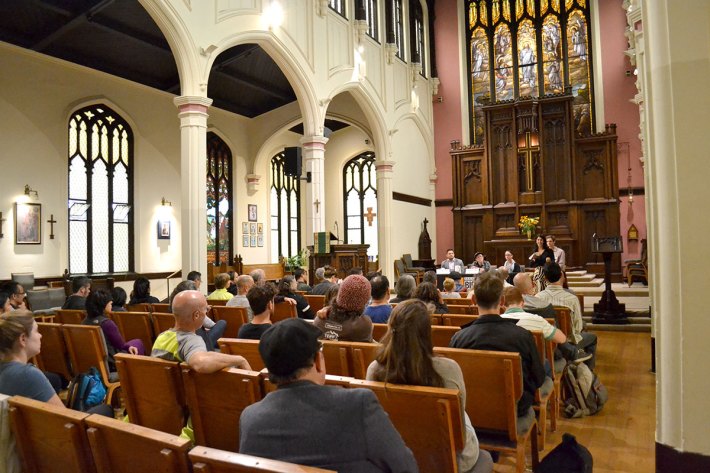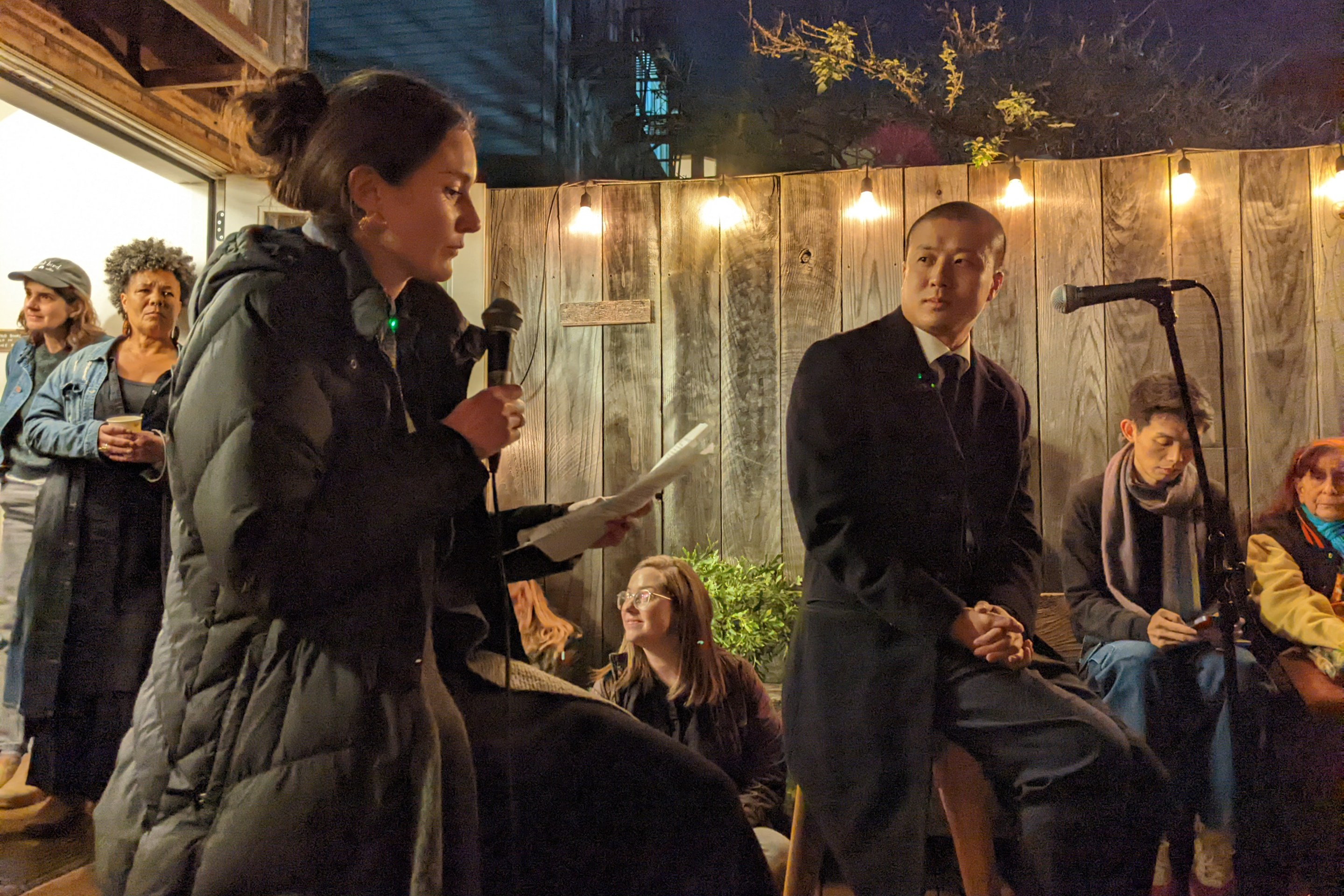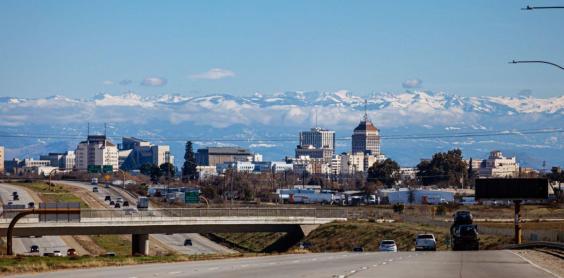Melodie, a woman in her late 50s who lives in a camper along one of the streets leading into the Hairball, pleaded with city officials and advocates to just give homeless people some sanctuary and peace. "There's no where else to go," she said to a group of some 40 bike and homeless advocates who attended a San Francisco Bicycle Coalition panel last night on homelessness in the Hairball.
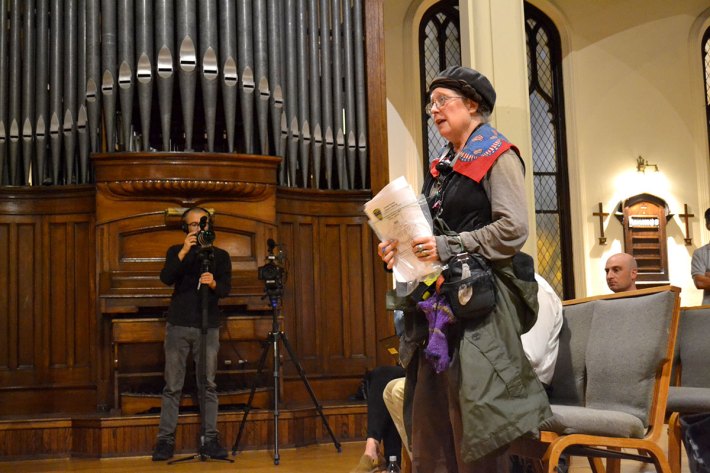
For those who aren't familiar, the Hairball refers to the tangle of freeway on-and-off ramps where Cesar Chavez crosses 101. A few years ago, dedicated bike paths and bridges were added through the ramp network to permit cyclist to safely navigate between the Mission neighborhood and Bernal to Potrero and points east.
When the bike paths opened three years ago, Streetsblog and the Bicycle Coalition celebrated it as a victory for the safe-streets community. But, as Streetsblog has covered previously, the bike lanes are now overrun with encampments, rendering them all but impassable. Last night's meeting, which brought together advocates and city officials at the Episcopal Church of St. John the Evangelist in the Mission, was intended to address some of the concerns.
"I’m not a person who’s easily scared or intimidated by homeless people," said Supervisor Hillary Ronen, whose district encompasses the area. "But I can see that if someone jumps out or attacks, that's incredibly intimidating."
Whether or not Ronen's concerns about getting attacked are justified, conflicts are happening. Back in January a cyclist, trying to navigate through the encampments on the bike path, swerved to miss a man who popped out of a tent. The cyclist snagged his handlebars on at shopping cart and crashed. It's a dangerous situation for everyone, including the homeless, and now many--if not most--cyclists avoid the route completely.
For Kelley Cutler with the Coalition on Homelessness, the Hairball conflicts are part of a nationwide issue that's going on in every corner of the country. "They’re dealing with the same thing in Alaska, where it’s freezing."
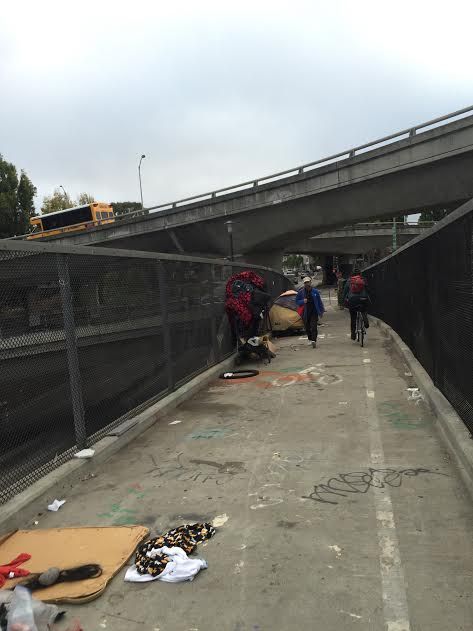
"The takeaway is that people living in encampments are our neighbors and to treat people with dignity and respect," said Emily Cohen with the San Francisco Department of Homelessness. Her department, she explained, is setting up so-called 'Navigation Centers'--city run shelters where social workers help reconnect homeless people with relatives, jobs, medical care, and, hopefully, get them set on a path back to a permanent roof over their heads. The idea is to clear the hairball encampments not by chasing them away, but by helping them rejoin society. "We don't approach a camp until we have the beds at the navigation centers to do it--so it's a real offer of someplace to go," she explained.
Cohen said they've made significant progress in the Hairball. "We did an assessment in August--there were 60 people living in the area, and now we're down to 35 or 45," she said, adding that they placed people into navigation centers, with "four more placements taking place this week." She said they're also doing health fairs to provide some medical care in the meantime and that they're "committed to dealing with encampments in the most humane and just way possible."
"The creation of the homeless department has been a really big improvement," said Cutler. She said things have improved since the last Superbowl, when homeless encampments were forcibly removed from Division Street, a few miles from the Hairball, during city sweeps. "It was brutal." To avoid a repeat of that, she said the homeless teams need time and resources and "tools to be able to do the work that they do."

Meanwhile, the California Department of Transportation owns most of the land under the freeway and Hairball, explained Luis Montoya, with the Livable Streets division at the SFMTA. Montoya explained how the Hairball was never designed by any one agency, and was instead layered on over several decades during the freeway building era--that's why the whole thing is such a disjointed physical and administrative mess. One of the bike paths is controlled by the SF Department of Public Works, but the rest belongs to Caltrans, he said. "We have no jurisdiction over it. And we’re not consulted when changes are made."
Caltrans regularly sweeps encampments from the land beside and under the freeway ramps. "Caltrans and the California Highway Patrol have been brutal," said Cutler. "I was talking to a CHP officer, who seemed to think he's helping someone by throwing their belongings away, because that will motivate them to get into shelters. And I’m like 'dude, you do realize the shelter's wait list is like three months?'" So homeless people set up camp on the bike bridges--the only part that Caltrans doesn't control.
Indeed, from Streetsblog's perspective, it remains a mystery as to why Caltrans insists on leaving areas under freeways fenced off and unused, often covered in garbage, but will take such extreme measures to clear out the homeless from the one place where nobody would otherwise bother them--and where they have a chance to stay dry in the rainy season. It's a horrible existence, but it's not improved by regularly throwing out all their possessions and tossing them onto a bike path or a sidewalk or a street. That said, it sounds as if the city has been pretty inhumane and extreme too at times--Melodie said the Department of Public Works sometimes clears them off the bike path by blasting them with water in the middle of the night.
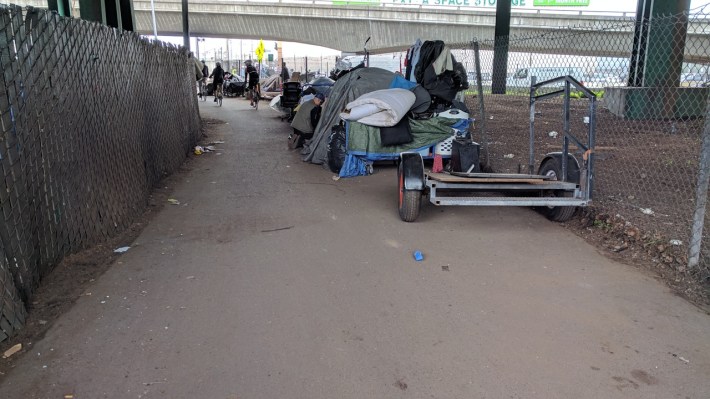
"The bottom line is we’re in a housing crisis--a report came out that approximately 4,353 people are un-sheltered [in San Francisco]," said Cutler. "If people are able to get into a Navigation Center and get connected with housing that's awesome, but if they’re not able to that’s when, as advocates and educators, we have to ask, where can they go? Where can people go?"
"There’s nowhere for us to go," said Melodie, fighting through tears. "And that’s how come we’re under the freeway. We’re just trying to get out of your hair, so you can get on with your life, so you can get to work ... that's why we're down there. And they're hosing us down with water at 4 a.m.!"
